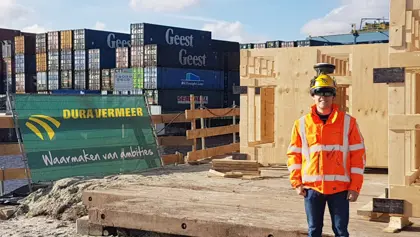Read more
Customer stories on OutSystems
Dura Vermeer builds in Low Code
Leveraging the Construction Logistics Model to reach zero emissions by 2050, reducing calculation time from 1 day to 2 hours.

Dura Vermeer is one of the most innovative and sustainability-minded construction companies in the Netherlands. With about 3,000 employees, they work on various residential construction, utility, and infrastructure projects, from new build to renovation and maintenance. The company aims to cut their CO2 emissions in half by 2030 and achieve a minimum of 90% CO2 emissions reduction by 2050 (with the remaining 10% being offset). But how do you calculate expected emissions and other important values before starting construction?
The impact of the construction sector on total CO2 emissions in the Netherlands is significant. “We have long been aware of the environmental impact, and that’s why we’ve internally researched the greatest sources of CO2 emissions in construction,” says Michael Stender, Manager of Digitalization at Dura Vermeer Construction and Real Estate. “Raw materials and energy consumption rank first and second, but logistics also plays a big role: we can decide which logistics partners to work with and influence the type of equipment they use.”
“Construction logistics have always been somewhat overlooked in the sector,” says Michael. Yet this is more relevant than ever. Not only because it's important to know how much CO2 is emitted in the process, but also because you want to minimize the hindrance to areas around the construction site. As cities become busier and more construction takes place in urban areas, this issue is attracting greater attention. A few years ago, one of their team members started systematically collecting data on construction logistics in an Excel file. “Which materials are necessary, how much of it fits in a truck, how many trucks are needed and when? Much of this information was tracked, along with CO2 emissions. These were complex calculations necessary to determine progress in various projects.”
At one point, the file consisted of dozens of tabs, and we had several versions in circulation. We wanted to scale this system, but in a way that would make it more manageable and user friendly, and that would allow us to deploy it in projects with new partners. We also wanted to prevent the file from leaking out, because we recognized that it’s unique in the construction sector.”
Dura Vermeer did not have a solution in house, and it turned out no one else in the market offered it either. Frans Mol, Dura Vermeer’s Manager of IT OPS, including application development: “We work in line with the principle ‘Re-use, before buy, before make’. We knew that a low-code application could be the answer, but at that point, our people did not have the time or capacity to develop one on their own. That’s when we asked our OutSystems low-code partner, HSO, to implement a solution.
With them, we work under the principle of ‘Teach me, help me, save me’, and in this case we resorted to the ‘help me’ method. OutSystems is a uniquely user-friendly system that doesn’t require programming knowledge. Users are guided through the process of building an application by a wizard and can easily add functions to customize it. Now we have our very own application, the Construction Logistics Model, which anyone can learn to use within 30 minutes. It’s visually appealing and we can extract a variety of useful reports from it.”
During the first session with HSO, it became clear how complex the Excel file had become over time. Frans: “We needed a few hours just to explain how it worked. But after this, HSO asked the right questions and understood exactly how the system needed to be configured. In short, we found that we were speaking the same language.”
"The Construction Logistics Model created in this way is now widely used in the organization and offers a lot of time savings: where making calculations in the past took a whole day, it is now done in two hours."

Significant time savings
During the development phase with HSO, the original creators of the Excel file continued to add features to the application, such as a route planner and the ability to calculate CO2 emissions by route. “The Construction Logistics Model that emerged is now widely used across the organization and offers significant savings: whereas making calculations used to take a whole day, it now only takes two hours,” says Michael.
The model also adds value because it makes a positive impression on customers. “We can objectively demonstrate what the impact of construction projects is on the environment. Then we can propose energy-efficient and CO2-friendly ways of building and transporting materials. For example, we can present an alternative to a situation where forty trucks would have to drive by a school or hospital. Offering these details has had a positive influence on several of our recent tenders.”
There are still plenty of ideas to expand this model. Beyond that, there are other initiatives within the organization where OutSystems, in partnership with HSO, is an integral part of the solution.
Read more
Customer stories on OutSystems
We, and third parties, use cookies on our website. We use cookies to keep statistics, to save your preferences, but also for marketing purposes (for example, tailoring advertisements). By clicking on 'Settings' you can read more about our cookies and adjust your preferences. By clicking 'Accept all', you agree to the use of all cookies as described in our privacy and cookie policy.
Purpose
This cookie is used to store your preferences regarding cookies. The history is stored in your local storage.
Cookies
Location of Processing
European Union
Technologies Used
Cookies
Expiration date
1 year
Why required?
Required web technologies and cookies make our website technically accessible to and usable for you. This applies to essential base functionalities such as navigation on the website, correct display in your internet browser or requesting your consent. Without these web technologies and cookies our website does not work.
Purpose
These cookies are stored to keep you logged into the website.
Cookies
Location of Processing
European Union
Technologies Used
Cookies
Expiration date
1 year
Why required?
Required web technologies and cookies make our website technically accessible to and usable for you. This applies to essential base functionalities such as navigation on the website, correct display in your internet browser or requesting your consent. Without these web technologies and cookies our website does not work.
Purpose
This cookie is used to submit forms to us in a safe way.
Cookies
Location of Processing
European Union
Technologies Used
Cookies
Expiration date
1 year
Why required?
Required web technologies and cookies make our website technically accessible to and usable for you. This applies to essential base functionalities such as navigation on the website, correct display in your internet browser or requesting your consent. Without these web technologies and cookies our website does not work.
Purpose
This service provided by Google is used to load specific tags (or trackers) based on your preferences and location.
Why required?
This web technology enables us to insert tags based on your preferences. It is required but adheres to your settings and will not load any tags if you do not consent to them.
Purpose
This cookie is used to store your preferences regarding language.
Cookies
Why required?
We use your browser language to determine which language to show on our website. When you change the default language, this cookie makes sure your language preference is persistent.
Purpose
This service is used to track anonymized analytics on the HSO.com application. We find it very important that your privacy is protected. Therefore, we collect and store this data anonymously on our own servers. This cookie helps us collect data from HSO.com so that we can improve the website. Examples of this are: it allows us to track engagement by page, measuring various events like scroll-depth, time on page and clicks.
Cookie
Purpose
With your consent, this website will load Google Analytics to track behavior across the site.
Cookies
Purpose
With your consent, this website will load the Google Advertising tag which enables HSO to report user activity from HSO.com to Google. This enables HSO to track conversions and create remarketing lists based on user activity on HSO.com.
Possible cookies
Please refer to the below page for an updated view of all possible cookies that the Google Ads tag may set.
Cookie information for Google's ad products (safety.google)
Technologies Used
Cookies
Purpose
With your consent, we use IPGeoLocation to retrieve a country code based on your IP address. We use this service to be able to trigger the right web technologies for the right people.
Purpose
With your consent, we use Leadfeeder to identify companies by their IP-addresses. Leadfeeder automatically filters out all users visiting from residential IP addresses and ISPs. All visit data is aggregated on the company level.
Cookies
Purpose
With your consent, this website will load the LinkedIn Insights tag which enables us to see analytical data on website performance, allows us to build audiences, and use retargeting as an advertising technique. Learn more about LinkedIn cookies here.
Cookies
Purpose
With your consent, this website will load the Microsoft Advertising Universal Event Tracking tag which enables HSO to report user activity from HSO.com to Microsoft Advertising. HSO can then create conversion goals to specify which subset of user actions on the website qualify to be counted as conversions. Similarly, HSO can create remarketing lists based on user activity on HSO.com and Microsoft Advertising matches the list definitions with UET logged user activity to put users into those lists.
Cookies
Technologies Used
Cookies
Purpose
With your consent, this website will load the Microsoft Dynamics 365 Marketing tag which enables HSO to score leads based on your level of interaction with the website. The cookie contains no personal information, but does uniquely identify a specific browser on a specific machine. Learn more about Microsoft Dynamics 365 Marketing cookies here.
Cookies
Technologies Used
Cookies
Purpose
With your consent, we use Spotler to measures more extensive recurring website visits based on IP address and draw up a profile of a visitor.
Cookies
Purpose
With your consent, this website will show videos embedded from Vimeo.
Technologies Used
Cookies
Purpose
With your consent, this website will show videos embedded from Youtube.
Cookies
Technologies Used
Cookies
Purpose
With your consent, this website will load the Meta-pixel tag which enables us to see analytical data on website performance, allows us to build audiences, and use retargeting as an advertising technique through platforms owned by Meta, like Facebook and Instagram. Learn more about Facebook cookies here. You can adjust how ads work for you on Facebook here.
Cookies
Purpose
With your consent, we use LeadInfo to identify companies by their IP-addresses. LeadInfo automatically filters out all users visiting from residential IP addresses and ISPs. These cookies are not shared with third parties under any circumstances.
Cookies
Purpose
With your consent, we use TechTarget to identify companies by their IP address(es).
Cookies
Purpose
With your consent, we use this service provided by uMarketingSuite to run A/B tests across the HSO.com application. A/B testing (also called split testing) is comparing two versions of a web page to learn how we can improve your experience.
Purpose
With your consent, we use this service provided by uMarketingSuite to personalize pages and content across the HSO.com application. Personalization helps us to tailor the website to your specific needs, aiming to improve your experience on HSO.com.
Purpose
With your consent, we use ZoomInfo to identify companies by their IP addresses. The data collected helps us understand which companies are visiting our website, enabling us to target sales and marketing efforts more effectively.
Cookies